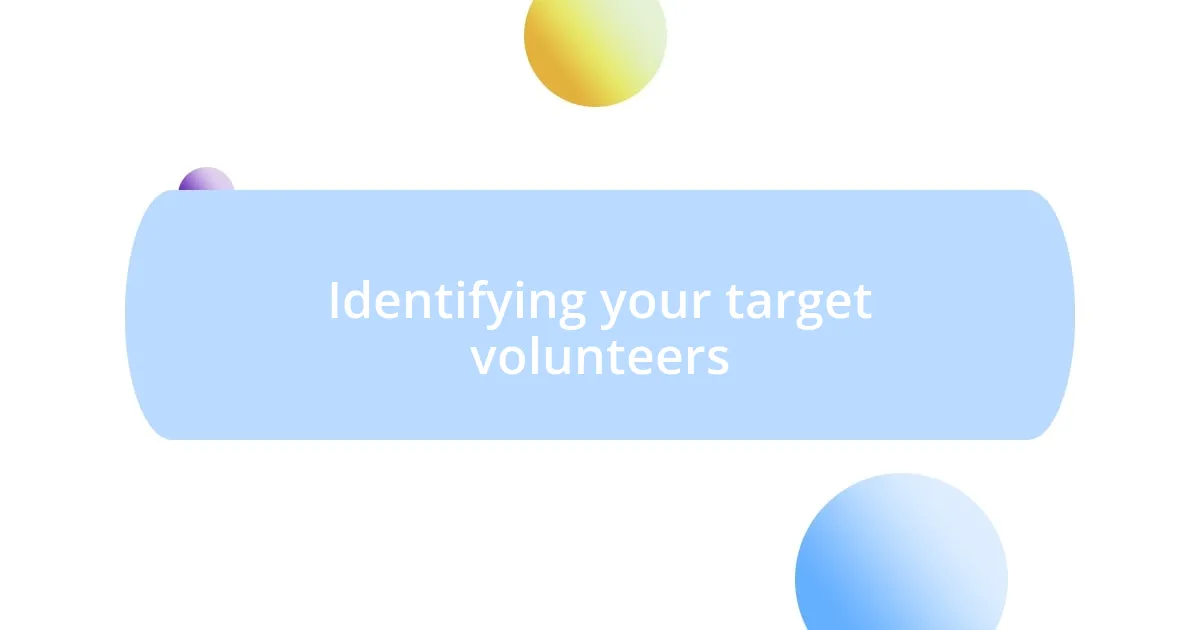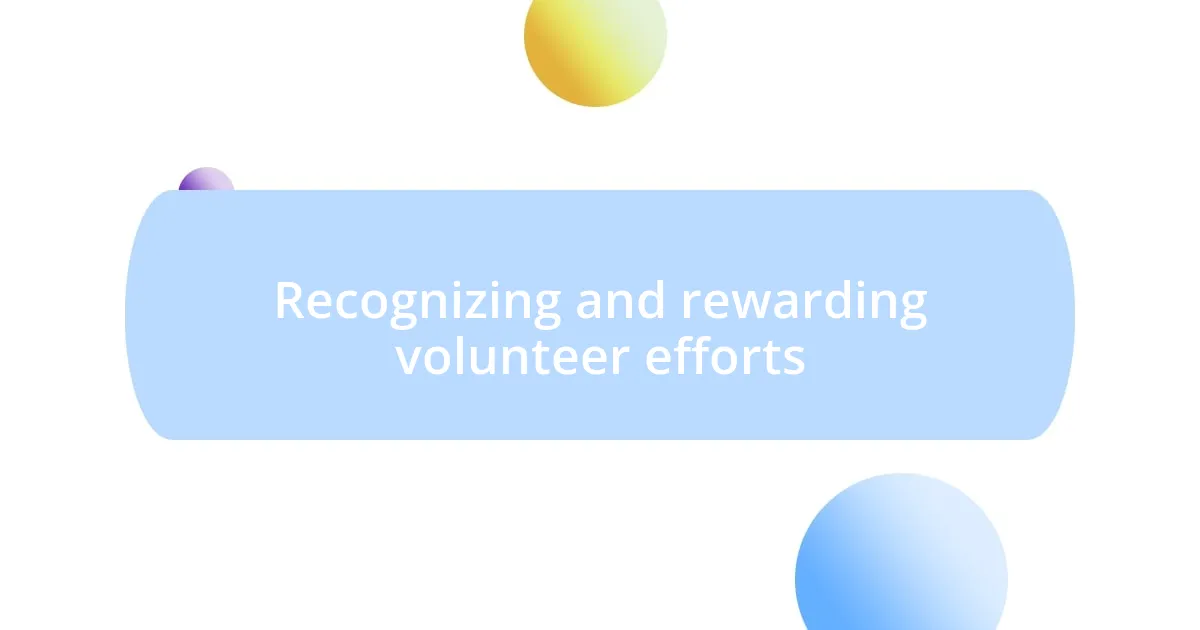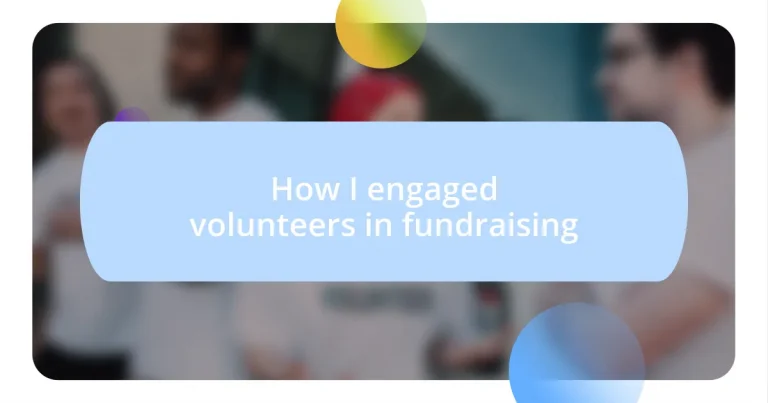Key takeaways:
- Identifying target volunteers is crucial; focus on specific skills, passions, and personal narratives to connect with them effectively.
- A compelling mission statement should evoke emotional connections, include personal stories, and be simple for better engagement.
- Building strong relationships through regular communication, appreciation, and fostering a friendly environment encourages volunteer loyalty.
- Evaluating impact via feedback sessions, anonymous surveys, and tracking metrics helps to align volunteer efforts with organizational goals.

Identifying your target volunteers
Identifying your target volunteers is like uncovering hidden treasures. In my experience, thinking about the specific skills and passions you need helps to hone in on the right people. For instance, when I organized a community clean-up, I focused on reaching out to environmental enthusiasts. They not only had the motivation but also the knowledge to make a more impactful event.
Have you ever thought about the different demographics within your community? It’s fascinating how each group can bring a unique perspective. For example, when I engaged college students for a charity run, their energy and enthusiasm were contagious. By aligning with their interests—like fitness and social media outreach—I not only found eager volunteers but also champions for promoting the event.
Additionally, consider the emotional motivators behind volunteerism. Many individuals are driven by personal experiences or challenges they’ve faced. When I met a volunteer who lost a loved one to a disease, their heartfelt story illuminated their passion. It made me realize that tapping into these narratives can help in understanding who might resonate deeply with your cause, creating a more authentic connection. Who knows? You might find someone whose journey aligns perfectly with your mission.

Creating a compelling mission statement
Creating a compelling mission statement is pivotal in uniting volunteers around a common purpose. From my experience, a well-crafted mission statement should resonate emotionally with both the volunteers and the community. For example, when I wrote a mission statement for a fundraiser to support children’s education, I shared a touching story about a girl from a disadvantaged background whose life was transformed by access to education. This narrative not only highlighted our goal but also stirred a sense of importance among potential volunteers.
A great mission statement evokes passion and sparks action. I remember when I collaborated with a group to draft a mission statement focused on promoting mental health awareness. We included personal anecdotes from volunteers about their struggles and triumphs. This raw honesty made the mission relatable, showing potential volunteers that their involvement could make a real difference in lives similar to their own. This sense of purpose can ignite motivation in others.
Moreover, simplicity is key. Volunteering often hinges on quick understanding and accessibility. When I streamlined my mission statement to focus on three core values, it became more digestible. Those three points felt like a rallying cry, prompting individuals to rally around our cause. After all, the clearer and more compelling the statement, the stronger the connection it fosters with potential volunteers, mobilizing them towards meaningful contributions.
| Key Elements | Importance |
|---|---|
| Emotional Connection | Engages volunteers on a personal level, motivating them to act. |
| Personal Narratives | Creates relatability and encourages potential volunteers to see themselves in the mission. |
| Simplicity | Ensures the message is easily understood, allowing for instant engagement. |

Developing engaging fundraising activities
Developing fundraising activities that truly engage volunteers requires creativity and an understanding of what excites them. I recall organizing a bake sale where volunteers could bring their favorite recipes to share. This not only encouraged participation but fostered a sense of community, as we swapped stories about family traditions tied to those dishes. Seeing their passion ignited by personal connections made the event more vibrant and memorable.
Here are a few engaging fundraising activities that I found effective:
– Themed Charity Walks: Everyone loves dressing up! Setting a fun theme can draw crowds and evoke excitement.
– Skill-Swap Fundraisers: Volunteers can teach a skill, like painting or cooking, in exchange for donations. It builds camaraderie and gives participants something valuable in return.
– Craft Fairs: I partnered with local artists, allowing volunteers to showcase and sell their work. This not only promoted their talents but also drew in community members to support the cause.
– Challenge Events: Think fun runs with a twist or obstacle courses. Volunteers not only participate but also motivate others to join in and fundraise together.
By tapping into personal stories and community interests, you create a lively atmosphere where volunteers feel valued and engaged.

Building strong relationships with volunteers
Building strong relationships with volunteers is a cornerstone of any successful fundraising initiative. I remember a time when I prioritized frequent check-ins with my volunteers, asking about their experiences and ideas. This simple act of listening not only deepened our bond but also opened the door for innovative suggestions that I hadn’t even considered.
I often think about the power of gratitude. One year, after a major event, I sent handwritten thank-you notes to each volunteer, sharing specific details about how their contributions made an impact. The look on their faces when we gathered to reflect on our achievements spoke volumes. They felt seen and valued, and I realized that such small gestures could spark lasting loyalty and encourage volunteers to return for future projects.
Creating a friendly and inclusive environment also greatly enhanced our relationships. I organized casual meet-and-greet sessions where volunteers could share their interests beyond fundraising. By knowing them personally, I could tap into their unique strengths when planning activities. It made me wonder: how often do we miss out on hidden talents just because we don’t take the time to connect on a personal level? Engaging with volunteers in this way not only strengthened our team dynamic but also enriched our fundraising efforts.

Implementing effective communication strategies
Effective communication strategies can significantly enhance volunteer engagement in fundraising endeavors. I often found that creating a transparent line of communication made all the difference. For instance, during a major fundraising campaign, I set up a group chat where volunteers could share their progress, ideas, and concerns. This fostered a sense of camaraderie, as everyone was in the loop and felt they were part of a collective effort, not just isolated contributors.
One technique that I found particularly impactful was storytelling. I made it a point to share the real-life impacts of our fundraising efforts regularly. I remember telling the story of a local family we helped through our previous campaigns. Seeing how their lives improved made our volunteers feel emotionally connected to the cause. It’s fascinating how a simple story can transform numbers and statistics into something tangible that people genuinely care about. Have you ever had that moment when a story compelled you to take action? I certainly have.
Additionally, I learned that adapting my communication style to fit the preferences of my volunteers was crucial. For example, while some preferred quick phone calls for updates, others thrived on detailed emails. Once, I conducted a quick survey to understand their preferences better. By doing so, I not only optimized our interactions but also showed volunteers that their opinions mattered. This small step cultivated a more personalized experience, leaving them feeling respected and understood. Isn’t it remarkable how tailoring your approach can foster a deeper connection?

Recognizing and rewarding volunteer efforts
Recognizing and rewarding volunteer efforts is absolutely essential in fostering long-term commitment. I still remember the first time I organized a small appreciation event for our volunteers. It was so heartwarming to see their surprised faces as I unveiled a simple yet meaningful awards ceremony. Acknowledging their hard work with certificates and small tokens left a lasting impression. It’s incredible how just a little recognition can make someone feel valued.
Creating opportunities for volunteers to share their experiences often leads to unexpected moments of gratitude. I encouraged my team to submit stories about their volunteering journey, and we compiled them into a celebratory booklet. When we presented it at a gathering, volunteers were moved to see their stories honored and showcased. They truly felt proud of their contributions. Don’t you think that recognizing individual journeys can create an even stronger sense of community?
Additionally, I found that offering unique incentives sparked enthusiasm among volunteers. For instance, I teamed up with local businesses to provide discounts and freebies to our volunteers as a thank-you for their efforts. The excitement on their faces when they received those little perks was undeniable. It made me realize that small gestures can foster a culture of appreciation. What do you think would motivate volunteers in your experience?

Evaluating volunteer impact and feedback
Evaluating the impact of volunteers in fundraising is like peeling back the layers of an onion; there’s always more to discover. After each campaign, I initiated a feedback session to reflect on what worked and what didn’t. I remember one such session where a volunteer candidly shared their struggle with the time commitment. Their honesty prompted a valuable discussion about balancing dedication with personal schedules, ultimately leading us to restructure our volunteer roles. Isn’t it fascinating how feedback can reveal insights that you might never have considered?
In addition to feedback sessions, I implemented anonymous surveys to gain unfiltered opinions about our fundraising initiatives. During one campaign, we discovered that some volunteers felt underutilized in their skills. This revelation pushed me to rearrange tasks and match individuals with projects aligned with their strengths. The energy shift was palpable—seeing volunteers thrive in roles that suited them sparked a renewed passion within the team. Have you ever experienced that moment when a simple survey led to significant changes?
Lastly, I believe that tracking metrics is crucial for evaluating volunteer impact. I started documenting volunteer hours, contributions, and results to paint a clearer picture of our fundraising milestones. For example, one year, I was thrilled to see that our combined efforts had not only surpassed our fundraising goal but had also increased volunteer participation by 40%. Celebrating these achievements alongside volunteers reinforced their significance and motivated the team for future campaigns. Does tracking play a role in how you assess your teams?














